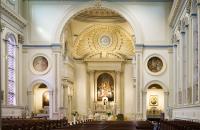Since it’s Holy Week, I thought I’d like to do daily Mass all week. It’s something that I’ve wanted to do for years but never had the chance. This is the lucky year!
Well, turns out St. Al was the eldest son of a wealthy family in Castiglione near Mantua, Italy. He was born in 1568. His father’s name was Ferrante. How about that, my maiden name! And they were part of the court of the Medici’s. My nephew married a Medici. So maybe I’m related to St. Aloysius!
Anyhow, when Aloysius, then know as Luigi (Aloysius is the Latin form of Luigi), was around 16, he decided he didn’t want to be a Marquis. He wanted that right to go to his brother so that he could enter the seminary. Ferrante wasn’t pleased and apparently there was a disagreement. Now, I come from an Italian home and I can assure you, there is either peace or war but there are no ‘disagreements’. I’m sure the Gonzaga household was a war zone. Luigi won out and began to study under a newly founded religious order, The Society of Jesus, also known as the Jesuits. (The Jesuits have founded both Gonzaga University in Spokane, WA and Georgetown University in Washington, DC.)
He studied for the priesthood in Rome. It was there that he would go out into the streets of the city to care for victims of the plague. and where he contracted the disease himself. He died on June 21, 1591, at the age of twenty-three, six years short of his ordination. Pope Benedict XIII canonized Aloysius a saint in 1726, and three years later declared him to be the patron of youth in the Catholic Church. His feast day is June 21.
Now when I attend daily Mass at that beautiful church in downtown DC, the painting behind the altar will mean much more to me!
You can read more detailed information about St. Aloysius Gonzaga on Wikipedia –> http://en.wikipedia.org/wiki/Aloysius_Gonzaga
Happy Easter!
Deneen






